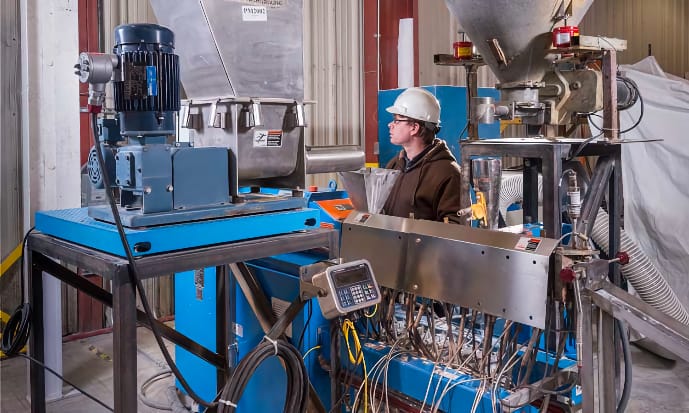
When you say “toll processing,” a volcano isn’t usually what comes to mind — but the image may provide the best example for explaining the ways extrusion enhances blending capabilities in the hands of toll processors with the right equipment and expertise.
Most people think of extrusion for metals or plastics in industrial or consumer applications, and for good reason. You’d be hard-pressed to go through an ordinary day without extruded products, from vehicles to furniture and from aluminum foil to water bottles … and much more. That macaroni or sausage you might have eaten for dinner? Those are extruded, too.
But food, pharmaceutical, and nutraceutical manufacturers also find extrusion valuable for homogenizing hard-to-blend ingredients and achieving extended or delayed release of active ingredients. The process is also in demand for pigments, polymers, and industrial chemicals.
But before we get into specifics, back to that volcano. Beneath the earth, molten rock encounters compression and shear forces as it moves through narrow gaps and cracks beneath the surface. Magma erupts through the earth’s crust and forms extrusive igneous rocks like basalt and pumice.
The force needed to liquify rock speaks to the power of extrusion for blending materials that are highly viscous — that is, resistant to flow. Let’s take a look at how your toll processor can help you harness the energy of extrusion to achieve your goals.
What is Extrusion?
To understand extrusion forces, think about the volcano. In an industrial context, compressive and shearing forces are created inside a twin-screw extruder. Inside the chamber (or barrel), the screws are rotated by motors, forcing raw materials through the narrow gaps between the shanks and threads.
Moving viscous materials — like finely milled metals, minerals, polymers, or other solids — through a rotating twin screw extruder requires a great deal of energy. That shearing force causes particle attrition and comminution through the extrusion process.
Process controls include screw speed and monitoring of torque, pressure, and melt viscosity. In addition, different machine zones can be heated to increase materials’ viscosity. The end result of all these variable adjustments can be a highly homogenous blend.
Metal, Ceramics, and Polymer Extrusion Applications
In many industries, extrusion enables manufacturers to lower costs by introducing inexpensive filler materials. The process’s outstanding blending capability enables fine control over ingredient ratios, to ensure the final blend performs to specifications.
Stronger materials can be created by introducing reinforcement additives, such as carbon or glass, via extrusion.
Extrusion equipment can allow for venting of volatile gases that may result when ingredients react during processing. This is especially useful for recycled plastics. Catalysts can also be introduced to blends during the process for polymerization or other chemical effects.
Toll processors can incorporate extrusion into a comprehensive processing service of blending, screening, and shaping or pelletizing.
Extrusion for Food, Pharmaceutical, and Nutraceutical Manufacturers
In the world of cGMP manufacturers, extrusion plays an important and growing role. While part of that role involves extruding raw materials into useful, valuable food ingredients or incorporating excipients such as pigments, fillers, and preservatives into pharma or nutraceutical blends, there’s more to it.
Extrusion enables drug manufacturers to improve delivery of otherwise difficult-to-use ingredients. Incorporating pharmaceutical polymers into a blend can impact ingredient activity by modifying, extending, or delaying a drug’s release inside the body.
cGMP-certified toll processors with extrusion expertise can serve as an extension of your own R&D team to test, trial, and scale up projects, and achieve effective formulations at lower overall costs. When it comes to process controls and variable adjustments, chemists and material scientists on your toll processor’s technical team add unique value. Tap into their process knowledge and achieve your desired characteristics with greater efficiency.
With Great Power Comes Great Opportunity
Harnessing high-energy shear forces creates new opportunities in a wide range of industrial, pharmaceutical, and food applications. But along with advanced technologies, it takes the right team of professionals to channel that energy into your desired product goals. You can start taking advantage of our chemists, material scientists, and particle technology experts just by reaching out — so contact us with your next material challenge.
And in the meantime, here’s an opportunity to increase your particle science knowledge. Our Particle Technology Glossary is an alphabetical list of some of the most commonly used terms in the toll processing world. Download your copy by clicking the link below.


.png?width=100&height=110&name=CPS-Logo-rgb-no-callout%20(1).png)